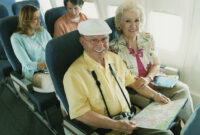Elderly travel tours represent a burgeoning sector in the tourism industry, catering to the specific needs and desires of a growing population of active seniors. This guide delves into the various aspects of planning and executing successful and enriching travel experiences for older adults, considering factors ranging from accessibility and health concerns to marketing strategies and itinerary design. We’ll explore different tour types, highlighting their unique selling propositions and addressing the logistical complexities involved in ensuring safe and enjoyable journeys.
From meticulously planned itineraries that incorporate rest and relaxation to engaging activities tailored to various fitness levels, we will examine how to create truly inclusive and memorable travel experiences. Understanding the specific needs and preferences of this demographic is crucial for building a successful and ethical business in this rewarding niche.
Types of Elderly Travel Tours
Choosing the right travel experience is crucial for older adults, ensuring both enjoyment and safety. Different tour types cater to varying preferences and physical capabilities, offering a range of enriching adventures. Careful consideration of individual needs and desires is key to selecting the perfect trip.
Elderly Travel Tour Categories
The following table outlines various elderly travel tour categories, highlighting their target audience, typical activities, and popular destinations. These are broad categories, and many tours blend elements from multiple types.
| Tour Type | Target Audience | Activities | Destinations |
|---|---|---|---|
| Relaxation Tours | Individuals seeking rest and rejuvenation; those with limited mobility. | Spa treatments, leisurely walks, quiet contemplation, gentle yoga, scenic drives. | Coastal resorts, spa towns (e.g., Baden-Baden, Germany; Palm Springs, USA), tranquil countryside locations. |
| Cultural Tours | Those interested in history, art, and local traditions; individuals with moderate mobility. | Museum visits, guided walking tours of historical sites, attending local performances, cooking classes, exploring local markets. | European capitals (e.g., Rome, Paris, London), Ancient cities (e.g., Athens, Kyoto), vibrant cultural hubs (e.g., Seville, Marrakech). |
| Historical Tours | Individuals with an interest in history and historical sites; those with moderate mobility. | Guided tours of historical landmarks, visits to museums and archives, lectures by historians, exploring ancient ruins. | Ancient Rome, historical sites in Greece, colonial cities in America, battlefields of Europe. |
| Adventure Tours (Modified) | Active individuals with good health and mobility; tours often offer adaptable options. | Gentle hiking, scenic boat trips, wildlife viewing (from accessible viewpoints), visits to national parks (with accessible paths). | National parks (with accessible trails), scenic coastal regions, areas with accessible wildlife viewing opportunities. |
Unique Selling Propositions of Each Tour Type
Each tour type offers a unique appeal. Relaxation tours prioritize stress reduction and rejuvenation, focusing on comfort and well-being. Cultural tours provide immersive experiences, fostering understanding and appreciation of different cultures. Historical tours delve into the past, offering insights into significant events and civilizations. Modified adventure tours cater to those seeking a more active experience while prioritizing safety and accessibility.
Physical Demands of Different Tour Types
The physical demands vary significantly across tour types. Relaxation tours generally involve minimal physical exertion, making them suitable for individuals with limited mobility. Cultural and historical tours typically involve moderate walking and standing, but often offer options for rest and breaks. Modified adventure tours require a higher level of physical fitness and mobility, although options are usually available to adapt activities to individual needs and abilities. It’s crucial to carefully review the itinerary and discuss any physical limitations with the tour operator before booking.
Closing Notes
Successfully planning and executing elderly travel tours requires a thoughtful approach that balances adventure and relaxation, caters to diverse needs, and prioritizes safety and well-being. By understanding the unique aspects of this market—from accessibility requirements and health considerations to effective marketing strategies and itinerary design—tour operators can create enriching and unforgettable travel experiences for their senior clientele. The focus should always remain on providing personalized and respectful service that allows older adults to explore the world with confidence and joy.




